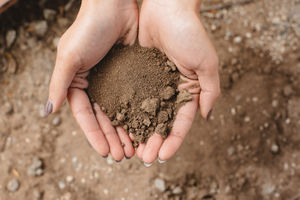Silt
Definition

Silt is a dust-like sediment that can be transported and deposited by water, ice, and wind. Silt particles are larger than clay, but smaller than sand. To be classified as silt, a particle must be between .05 to .002 mm. Similarly to clay, sand, and gravel, silt is found in soil. Silt can also occur as sediment mixed in suspension with water. Because of silt’s spherical shape, it retains a large amount of water. Silty soil is known to be more fertile than other soils, and many species of organisms thrive in it.
Classification
Formation
See also
- Clay
- Loam
- Founders of Soil Concepts
- Humus
- Microorganisms
- Pedogenesis
- Soil
- Soil Textures
- Soil Properties
- Jenny Equation
References
[1] Walter, David Evans, Gerald Krantz, and Evert Lindquist. 1996. Acari. The Mites. Version 13 December 1996. http://tolweb.org/Acari/2554/1996.12.13 inThe Tree of Life Web Project, http://tolweb.org/
[2] Pepato, Almir R, et al. “Phylogenetic Position of the Acariform Mites: Sensitivity to Homology Assessment under Total Evidence.” BMC Evolutionary Biology, BioMed Central, 2 Aug. 2010, bmcevolbiol.biomedcentral.com/articles/10.1186/1471-2148-10-235.
[3] Sanggaard, Kristian W.; Bechsgaard, Jesper S.; Fang, Xiaodong (6 May 2014). "Spider genomes provide insight into composition and evolution of venom and silk". Nature Communications. 5: 3765. Bibcode:2014NatCo...5E3765S. doi:10.1038/ncomms4765. PMC 4273655 Freely accessible. PMID 24801114.
[4] Dhooria M.S. (2016) Morphology and Anatomy of Acari. In: Fundamentals of Applied Acarology. Springer, Singapore
[5] “Acari.” Acari - Entomologists' Glossary - Amateur Entomologists' Society (AES), www.amentsoc.org/insects/glossary/terms/acari.
[6] Wilson, Nixon A. “Acarid.” Encyclopædia Britannica, Encyclopædia Britannica, Inc., 27 Dec. 2017, www.britannica.com/animal/acarid.
[7] NCSU Veterinary Parasitology, parasitology.cvm.ncsu.edu/vmp930/keys/mites/miteterms.html.
[8] Gulvik, M. "Mites (Acari) as indicators of soil biodiversity and land use monitoring: a review." Polish Journal of Ecology 55.3 (2007): 415.